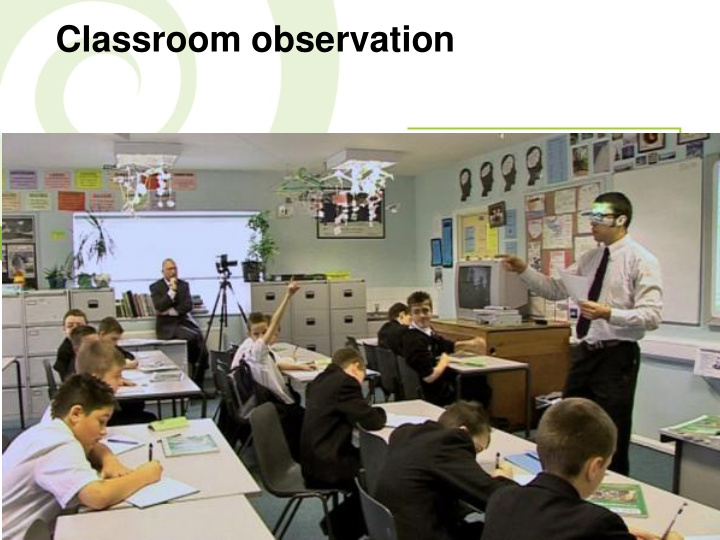



Classroom observation
Classroom observation – Watch the impact not the teacher!
1100+ meta-analysis 65,000 studies, and ¼ billion students and now adding affective outcomes
No. of effects d=.40
Yes, there are high and low probability teaching methods (based on 541 metas, about 30,000 studies, and 30m students) High probability ES RANK Low Probability ES RANK Conceptual change programs 1.16 5 Inquiry based teaching 0.35 101 Response to intervention 1.07 6 Online, digital tools 0.32 111 Cognitive task analysis 0.87 9 Homework 0.29 120 Teaching test taking & Classroom discussion 0.82 10 coaching 0.27 124 Reciprocal teaching 0.74 14 Use of powerpoint 0.26 128 Feedback interventions 0.73 15 Individualized instruction 0.23 138 Acceleration (gifted) 0.68 17 Programmed instruction 0.23 140 Concept mapping 0.64 21 Matching style of learning 0.23 143 Problem solving teaching 0.63 22 Co-/ Team teaching 0.19 154 Direct Instruction 0.60 28 Problem based learning 0.15 164 Repeated Reading programs 0.60 29 Perceptual-Motor programs 0.08 176 Mastery learning 0.57 36 Whole language 0.06 180
Yes, there are high and low probability teaching methods (based on 541 metas, about 30,000 studies, and 30m students) High probability ES RANK Low Probability ES RANK Conceptual change programs 1.16 5 Inquiry based teaching 0.35 101 Response to intervention 1.07 6 Online, digital tools 0.32 111 Cognitive task analysis 0.87 9 Homework 0.29 120 Teaching test taking & Classroom discussion 0.82 10 coaching 0.27 124 Reciprocal teaching 0.74 14 Use of powerpoint 0.26 128 Feedback interventions 0.73 15 Individualized instruction 0.23 138 Acceleration (gifted) 0.68 17 Programmed instruction 0.23 140 Concept mapping 0.64 21 Matching style of learning 0.23 143 Problem solving teaching 0.63 22 Co-/ Team teaching 0.19 154 Direct Instruction 0.60 28 Problem based learning 0.15 164 Repeated Reading programs 0.60 29 Perceptual-Motor programs 0.08 176 Mastery learning 0.57 36 Whole language 0.06 180
Classroom observations based on watching teachers teach are thus fraught with the problems of confusing teaching methods with learning impact. 1. Too molecular on what teacher does The teacher cites intra- and interdisciplinary content relationships The teacher plans demonstrate awareness of possible student misconceptions and how they can be addressed The teacher's plans reflect recent developments in content-related pedagogy The teacher seeks out information from a students about their cultural heritages The teacher maintains a system of updated student records and incorporates medical and/or learning needs into lesson plans The teacher has ongoing relationships with colleges and universities that support student learning The teacher manages a log of resources for student reference Lesson plans differentiate for individual student needs Assessments provide opportunities for student choice Teacher designed assessments are authentic, with real-word applications as appropriate There is total alignment between the learning activities and the physical environment
Classroom observations based on watching teachers teach are thus fraught with the problems of confusing teaching methods with learning impact. 1. Too molecular on what teacher does 2. Depends on nature of incoming students ( Whitehurst, Chingos, & Lindquist, 2014) 100 90 Top 20% 80 Second highest 20% 70 Middle 20% 60 50 Second lowest 20% 40 Bottom 20% 30 20 10 0 Lowest Second lowest Middle Second highest Highest Average incoming achievement level of teachers' students (Quintiles)
Top of the charts -- Teacher impacts on students RANK Teacher Impacts on Students ES RANK Teacher Impacts on Students ES 1 Teacher estimates of prior achievement 1.62 17 Acceleration 0.68 2 Collective teacher efficacy 1.57 18 Creativity programs 0.65 3 Student estimates of prior achievement 1.33 21 Concept mapping 0.64 5 Conceptual change programs 1.16 22 Problem solving teaching 0.63 6 Response to intervention 1.07 23 Classroom behavioral 0.63 9 Cognitive task analysis 0.87 24 Vocabulary programs 0.62 10 Classroom discussion 0.82 28 Direct Instruction 0.60 14 Reciprocal teaching 0.74 29 Repeated Reading programs 0.60 15 Feedback 0.73 36 Mastery learning 0.57 Providing formative evaluation to 16 teachers 0.68 41 Comprehension programs 0.55
Classroom observations based on watching teachers teach are thus fraught with the problems of confusing teaching methods with learning impact. 1. Too molecular on what teacher does 2. Depends on nature of incoming students 3. Reliability – need at least 3 lessons by 2 raters 4. Halo effects – Impressions linger 5. Depends on who observes 6. Voice and clothes among the highest biases 6. Criteria of success: surface or far transfer, reinvestment in learning 7. Restriction of range 8. The weighting problem 9. Reporting back can be poor … Teachers as graziers 10. Can you observe a teacher when the teacher is silent 11. Students who share a classroom experience can have very different learning opportunities and experiences 12. The importance of peer effects
It is a sin to watch a teacher, watch their impact
Developing observation of teacher impact on students Illustrative Dimensions of a Limited-Focus Classroom Observation Form • Learning Targets. • Cognitive Engagement. • Command of Content. • Question Quality. • Practice Opportunities. • Formative Assessment. • Classroom Climate.
The Visible Classroom 14
Ai-Live Technology Overview 15
Coding Changes over time ES 1 Deepen understanding .41 Provides immediate, specific and corrective feedback 2 Connect ideas Provides student with opportunity to deepen 3 Scaffolded activities .39 understanding, 4 Collaborate .37 Sets clear behaviour expectations 5 Connections 6 Open-ended Students have opportunity to ask task-related questions .31 7 Closed-ended .31 Emphasises important points 8 Introduces & explains 9 Resources Concludes the lesson by recapitulating/summarising key 10 Important points .31 11 Instructions 12 Feedback Repeats comment or question from student before 13 Review answering -.27 14 Prompting 15 Goals Asks closed questions or questions which have one -.44 correct answer 16 Repeats comment Provides step by step instructions on completing 17 Summarise -.47 tasks/activities 18 Behaviour Praise & positive Introduces and explains new/complicated vocabulary, -.47 19 environment
Visible Teaching – Visible Learning When teachers SEE learning through the eyes of the student and when students SEE themselves as their own teachers.
It’s about growth: Know thy impact jhattie@unimelb.edu.au Visible learning in action
Recommend
More recommend